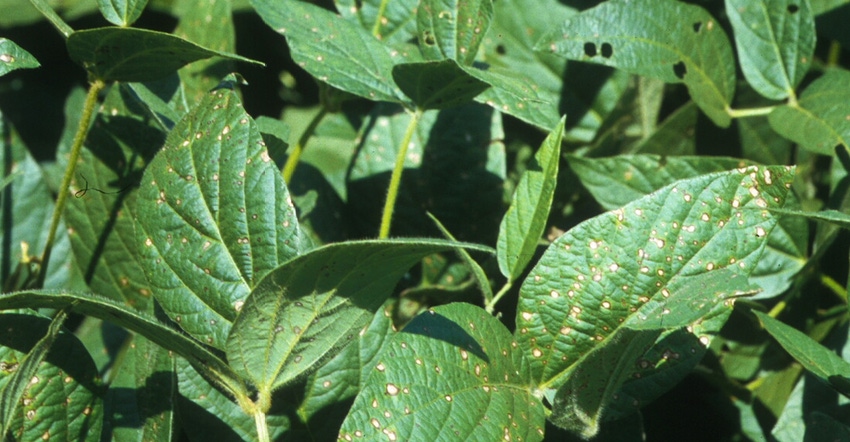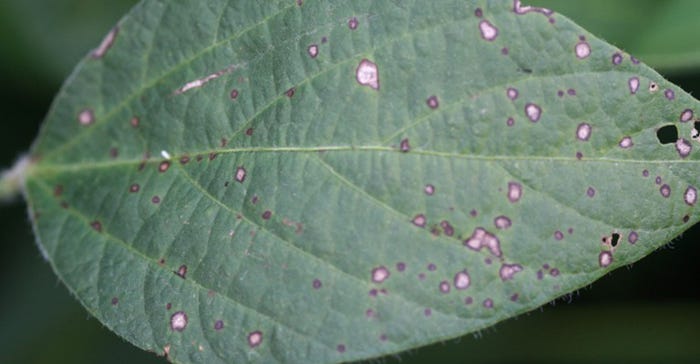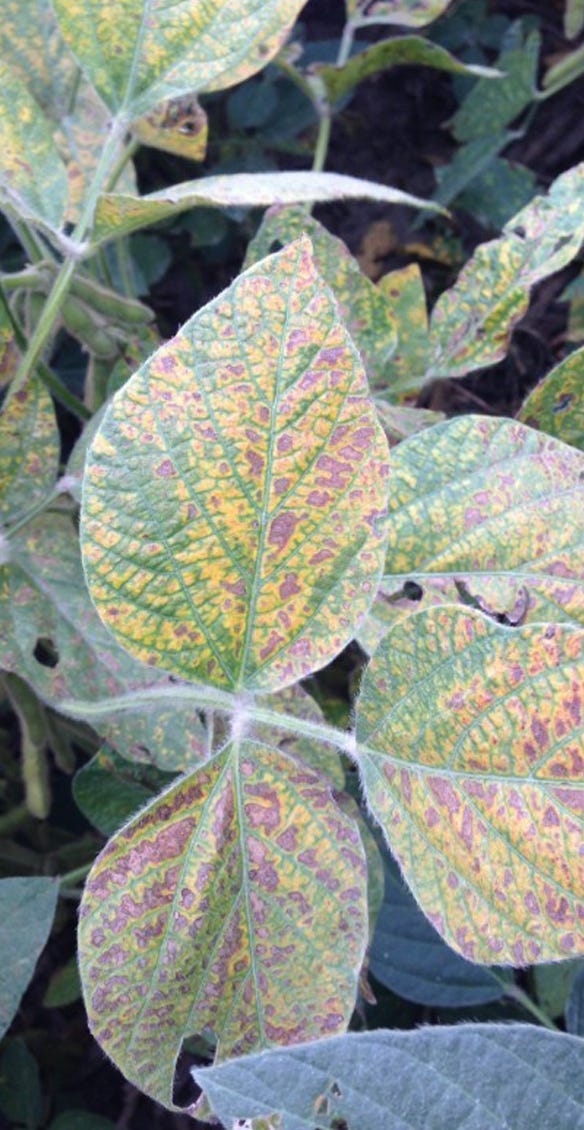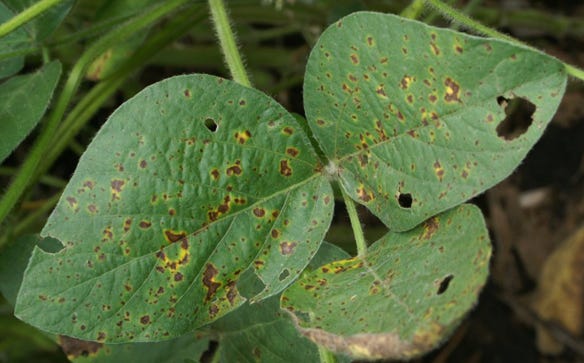October 22, 2018

Looking back at the prevalent diseases that appeared this year in Iowa soybean fields is helpful. “It’s important to review these diseases, so farmers, agronomists and all of our partners can make informed decisions ahead of next year’s growing season,” says Daren Mueller, an Iowa State University Extension plant pathologist.
These decisions include selecting varieties, choosing seed treatments, developing pre-germination checklists, evaluating the cost-effectiveness of a fungicide application and using cultural practices such as crop rotation, Mueller says.
These disease control strategies are all part of integrated pest management (IPM). While the risk of many soybean diseases occurring was low this year, future growing seasons may be different.
Frogeye leaf spot

At the top of the list is frogeye leaf spot, caused by the fungus Cercospora sojina. In late July and in August, ISU agronomists began reporting the tell-tale symptoms of round-to-angular lesions on soybean leaves, with a light tan center surrounded by a reddish-purple margin on the leaves.
Frogeye leaf spot’s impact on yields can vary greatly, depending on timing of disease appearance, the bean variety’s susceptibility to disease and weather conditions during soybean reproductive stages.
“We won’t know the full impact of the disease on yield until harvest concludes,” Mueller says. “If the disease begins late in the reproductive stages [after R5.5], or if disease severity is low, the yield impact will likely be minimal.”
Conditions favorable to disease development include warm, humid weather, with frequent rains that persist over an extended period. Several days of overcast weather can also increase the spread of the fungus, he notes. If conditions are favorable to the disease and severe outbreaks occur early or just after flowering, yield losses can be up to 35%.
What can you do to control frogeye?
While the disease didn’t have had much impact this year, it can become a problem in future years, as the spores can overwinter in Iowa crop fields, Mueller says.
The resistance gene that’s available in certain soybean varieties, known as Rcs3, has been effective against all races of this fungus known to occur in North America. “Crop rotation and tillage can also be effective in reducing the amount of fungus available to infect the next soybean crop. Long rotations may be necessary if the disease has been severe in a particular field,” he says.
Well-timed foliar fungicide applications can effectively control frogeye leaf spot, he says. Research shows that applying a fungicide during pod development (R3 to R4) is the most effective for managing the disease. Fungicide applications are generally more profitable when disease risk is high.
Sudden death syndrome

In second place this year was SDS. Probably the most recognizable soybean disease in North America, it is caused by the fungus Fusarium virguliforme. Reports of this disease were found at ISU research farms beginning in mid-July.
Symptoms of SDS include yellow spots between leaf veins that turn brown as the spots expand, eventually leading to defoliation. Underground, roots will be discolored and show decay (sometimes with no foliar symptoms). When soils are wet, the SDS fungus can reproduce on root surfaces, producing a mass of spores that are purple-blue in color.
As with all diseases, yield loss can vary greatly with SDS, and the loss depends upon multiple factors, Mueller explains. Cool, wet field conditions shortly after planting favor early root infections and disease establishment. Frequent or heavy rains midseason can favor early symptom expression.
Yield losses can be substantial in years when susceptible soybean varieties are planted in cool, wet fields with a history of SDS and soybean cyst nematode. If symptoms develop later in the season or weather isn’t conducive for disease development, yield losses can be minimal.
SDS can still become a problem
At ISU research farms, soybeans were around R3 to R5 growth stage when symptoms were observed. In some areas of Iowa, high volumes of rain were the typical weather forecast last summer. This disease often occurs in patches.
“If foliar symptoms appear at or after growth stage R6, yield loss may be minimal,” Mueller says. While yields might not have been severely impacted, he says, “SDS can still become a problem for soybean farmers, especially in the presence of SCN, and in cases where there is no crop rotation. Because SCN causes wounds to the root system, the plants are more susceptible to the fusarium fungus. There are no soybean varieties completely resistant to SDS, but partially resistant varieties are available.”
There are seed treatments that are effective, such as the fungicide fluopyram (ILeVO from Bayer CropScience), which has efficacy against SDS. “As a seed treatment, fluopyram has reduced SDS severity and protected yield on susceptible varieties, compared to a base seed treatment in several research trials conducted by Extension plant pathologists in the north-central U.S.,” Mueller says.
Planting partially resistant varieties doesn’t ensure complete control of the disease, but it will minimize yield loss, he says. It’s important to remember that weather and field conditions drastically influence disease severity. Testing the soil in your fields to get an idea of the size of the SCN population present, as well as purchasing a SCN-resistant soybean variety to plant, could delay SDS. Research shows that tillage can help in reducing SDS, but research also shows that no-till can also reduce the disease.
Septoria brown spot

Last on the list is Septoria brown spot. Brown spot is usually the first leaf disease to occur on soybeans in Iowa during the growing season, and it may be observed on soybeans as early as the V2 stage of soybean growth.
In 2018, reports of brown spot began arriving in late July, when soybeans were between R3 and R4, and mostly with full pods. Unlike many foliar diseases of soybean, brown spot starts in the lower canopy and continues upward.
“Currently in Iowa, brown spot hasn’t been making much of an impact on yields,” Mueller says. “It’s a disease that’s common in many fields each year, but fungicide application will not likely be profitable unless the disease spreads into the upper canopy.”
Symptoms of this disease are small purple or brown lesions on lower canopy leaves, progressing to irregularly shaped dark brown lesions on higher canopy leaves, as well as leaves yellowing around spots that leads to foliage death.
Favorable conditions for brown spot development are warm temperatures (in the 80s) and rainy weather. Considering the wet start and end of the 2018 growing season, conditions favored development of brown spot this year.
How do you stop brown spot?
To stop brown spot from occurring, it’s important to know that no soybean cultivars are resistant to the fungus, Mueller says. So, soybean variety choice isn’t an option for control.
“Fungicides are not recommended because this disease’s impact on yields is minimal, and fungicide application isn’t likely to be profitable solely for brown spot management,” he adds. “Rotating the field to a nonhost crop such as alfalfa, corn or a small grain is also beneficial for reducing this disease.”
Source: Iowa State University
You May Also Like




